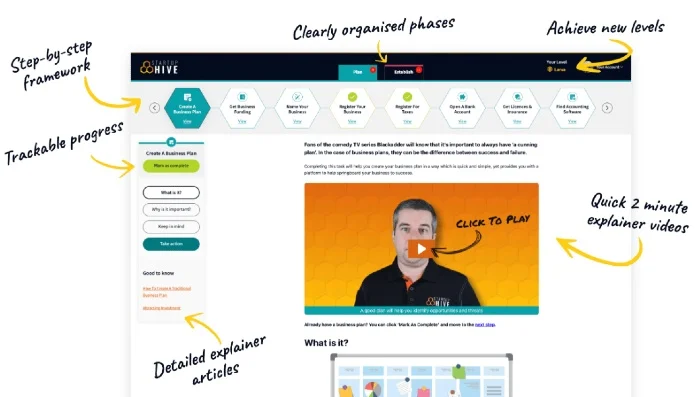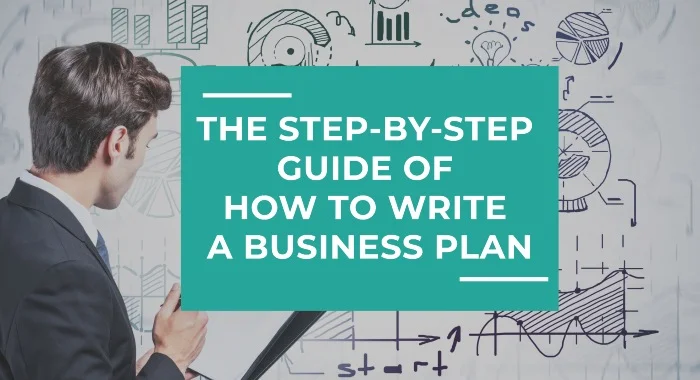You may have plenty of great ideas, but understanding how to write a business plan is essential if you want to grow your business, gain funding, and more.
Yet, a lot of startups don’t take the time to make one or don’t often see the advantage that they can bring.
Those with a business plan grew an average of 30% faster than those that didn’t. What’s more, they were 2x more likely to get investments or secure loans than those without.
Ready to learn how to write a business plan? We’ve got the step-by-step instructions you need to write a business plan that works.
Let’s get started.
What is a business plan?
Before we dive into the details of writing a business plan, let’s just recap what one is.
A business plan is a written document that describes your business. It may not sound like a lot, but it’s an in-depth guide to who you are, what you do, and how your business works. It’s useful for every business, whether you’re registered as a sole trader or limited company.
A business plan covers all different subjects, such as:
- Your business objectives and goals
- Your employees and business structure
- Your products and how you market them
- Your customers, competitors, and industry
- Your financial information and funding needed
Fundamentally, a business plan is there to clarify what your business is, set out your goals, spot any potential problems and set yourself up to grow.
Why do I need a business plan?

If you want to get an investment from your business, you’ll need a business plan to show to your lender or investors. This is to show them exactly what the money is for, how it will be used and, more importantly, how it will make enough money to pay back the initial investment.
Your business plan is proof that you can be trusted with the investment and that you will pay it back. It’s peace of mind for your investors that you’re worth giving money to, and depending on the type of funding, that your business will be a valuable project for them.
Without a business plan, you’ll find it hard to secure funding that doesn’t come from personal sources. That’s one of the reasons why understanding how to write a business plan is so important.
In addition, business plans are a great way to really solidify what your plans are and how you’ll grow. It forces you into asking some hard-hitting questions about your business, allowing you to solve problems because they cause big roadblocks for your company.
How to write a business plan
Right, now we’ve hammered home why you need a business plan, it’s time to start writing. But, before you open the document and get alarmed by the blank page that’s in front of you, here’s some advice.
There’s no right or wrong way to write a business plan. This process is designed to help you uncover information about your company and guide you, not dictate every decision you’ll ever make from this point. So, breathe, relax and let us guide you through it.
Generally, there are two types of business plans that exist:
- A traditional business plan
- A lean startup business plan
Traditional business plans are more common and might be what you’re more familiar with. These can be dozens of pages long that list in detail about every aspect of your company.
On the other hand, lean startup pages are only a page long.
They’re not often used to secure investments but as a way to summarise a business plan into key bullet points. According to Mas et al. (2021), the business plan is a crucial component in sharing both practical and theoretical knowledge between the entrepreneur and shareholders in startups.
If you’re looking for a way to get the basics out of the way quickly, this type of business plan might be for you.
Starting A UK Business?
Get rid of the confusion and always know what to do next with Startup Hive, the step-by-step platform created by the Business4Beginners team.
- FREE Step-By-Step Platform
- FREE Bank Account
- FREE Bookkeeping Software
- FREE Email Platform
- FREE Domain Name
- Discounted Company Formation
- Plus Much, Much More!

Join today for 100% FREE access to the entire Plan & Establish phases, taking you from validating your business idea through to setting it up, getting your accounts sorted, and creating a website.
“Excellent guide to build your business”
“The perfect starting point”
“Incredibly simple and intuitive to use”
Startup Hive is your trusted companion as you look to turn all of your business dreams into reality. Join today for free.
—
If you’ve never written a business plan before, it can be a good idea to start with a lean startup plan to get an overview of your business and goals. You may also want to write a traditional plan afterwards to help you focus more clearly on these objectives and map out your roadmap in more detail.
Even if you aren’t showing these documents to investors at this stage, they’re good internal documents to look back on to keep you on the right path.
The efficacy of this was even studied as early as 1993! Baker et al. (1993) found that industry leaders used written business plans for regular internal management purposes.
Once you’ve decided which type of business plan you need, scroll down to the right section to follow our step-by-step instructions on how to write a business plan.
How to write a traditional business plan

A traditional business plan is a more in-depth document that details almost every aspect of your company. If you want a thorough overview of your business or are trying to secure investment, this is the plan that you need.
It’s made up of the following sections:
- Executive summary
- Company description
- Market research
- Organisation and management
- Product or service
- Marketing and sales strategy
- Funding requests
- Financial forecasts
- Appendix
Okay, that list may look daunting. But to help you through it, we’ll guide you through the business plan section by section, telling you what it’s about, what you need to include, and examples to give you the right idea.
Right, let’s get started.
1. Executive summary
One of the first things we need to cover in our guide to how to write a business plan is the executive summary.
An executive summary is a high-level overview of your business.
Its purpose is to describe your company to those that don’t have time to read your entire business plan, enticing them into finding out more about your company.
In other words, the executive summary details the company’s present status and the direction of its future development (Haag, 2013).
It should include information about:
- What your business does in a nutshell;
- What your product or services are;
- Who you sell to;
- What makes you different.
You’ll go into these factors in more detail later on, so don’t try to get everything in your executive summary. If you’re using your mission statement to apply for funding, it’s also a good idea to include a summary of the amounts here too.
Although you don’t have any set word counts for any part of your business plan, you don’t want to go past a page for your executive summary. The key is the word summary here. Keep it short, sweet and easy to read.
And because it’s a summary, it’s sometimes helpful to write this section last. That way you’ve had a chance to really think about everything in detail and hone in one the most important parts you want to portray here.
Example executive summary
Lick O’ Paint is an interior design and home decorating company. Its services include interior design work, home renovations, painting and decorating, and custom artwork.
Customers
Lick O’ Paint is for design-conscious home-owners who want to create a magical space for their home but are dissatisfied with the ordinary designs from other home decorating companies.
Unique Selling Point
Unlike other decorating companies, Lick O’ Paint was founded by an award-winning artist that not only can find pieces to fit a room but design and produce artwork bespoke for the space.
2. Company description

This is your section to provide detailed information about your company and what you do.
A company description is made from these key elements:
- A mission statement
- Your history
- Your goals and objectives
- Your principal members
If you’ve never written a mission statement before, this a 1-2 line description of why your business exists. It’s not simply a summary of what you do or what you sell, it’s the reason why you sell these products in the first place.
For example, Nike’s mission statement isn’t to create sportswear. It’s to “Bring inspiration and innovation to every athlete in the world”. Powerful stuff.
Example company description
Mission statement
To transform houses into stunning homes full of life and personality.
History
Lick O’ Paint was founded in 2020 by award-winning artist Andie Bootstraps, after life-long friend Mark O’Chopping paid for, and was disappointed in, a recent home renovation. Stepping in to help recover the bland and lifeless space with bespoke art, Andie and Mark realised a gap in the market for those that want stunning and personal homes, without having to do everything themselves.
Goals and objectives
- Gain a glowing reputation as the best interior design company in the Midlands.
- Complete at least 6 full renovations during year one, and 10 one-room makeovers.
- To double revenue in the first 2 years from £250,000 to £500,000.
Principal Members
- Andie Bootstraps – owner and head designer
- Mark O’Chopping – business manager/sales
- Gary Cannon – decorator and trades specialist
3. Market analysis

This is where you go into detail about your particular industry and where you sit within it. To do this section, you’ll need to carry out competitive research about other businesses that are similar to yours and the advantages or weaknesses you have over them.
When doing comparative analysis, ask questions such as:
- What are your competitors doing well?
- Do they offer any services that you don’t?
- Do you offer services that they don’t?
- What do customers say about them?
- How do they market their company?
- Who are their customers?
And so forth.
Competitive analysis isn’t the time for blind-ego. Don’t just use this space to claim you’re better than anyone else. Instead, take a more honest look at the companies around you and what you can learn from them.
This section is also the space to expand on your target customers in more detail.
Example market analysis
Industry
Lick O’ Paint is within the design and home trades industry. During the 2020 coronavirus pandemic, home renovations and DIY projects took a 200% increase, increasing revenue by £3.4 billion in the UK, proving an incredibly lucrative industry and time to invest in a company.
Lick O’ Paint’s biggest competitors are The DIY-ers, which specialises in completing home renovation work, and The Home Designers, a team of interior designers that have won the ‘Best Designed Home’ award for the last three years running.
Unlike Lick O’ Paint, none of the competitors is founded by an award-winning artist who can design bespoke artwork as part of the home renovation packages.
Detailed description of customers
Lick O’ Paint customers are between the ages of 30-60 with a household income of £50,000+.
They are design-conscious home-owners who want to create a magical space for their home, but are dissatisfied with the ordinary designs from other home decorating companies.
Working full-time, our customers don’t have the time nor desire to complete DIY projects themselves and would rather use their home to relax after a long day. Instead of decorating themselves, they would rather outsource the work for a professional finish.
Company advantages
Lick O’ Paint’s biggest advantage is that we provide both interior design, home renovations and bespoke artwork by award-winning artist and founder Andie Bootstraps.
In addition, Lick O’ Paint stands out due to:
- Fully bespoke/unique designs for each client.
- Artwork that is created for the space, not found to ‘dress’ it afterwards.
- In-depth consultations before every project to really get a sense of the home-owners personality.
4. Organisation and management

This is where you list how your company is structured and who will be running it.
For this section, you might want to include CV’s of your key personnel to help paint a better picture of your company. These CV’s can be uploaded to the appendix, so the reader can quickly jump to and find the information they need.
5. Product or service
So, what does your company actually sell?
This is the section to lay down exactly what services or the types of products you offer. You don’t need to include your entire category, but give an overview of everything that your company does and extra information such as a product lifecycle, production, and distribution, or any research and development into future productions.
This is also the section to include your pricing structure and how much you charge for each service.
Example product or service
Product/Service
Services include:
- Interior design planning and services
- Design consultations
- Painting and decorating services
- Bespoke room design and planning
- Custom Andie Bootstraps interior artwork
- Full home renovations
Pricing structure
Prices are determined on a case-by-case basis dependent on the level of work involved. As a base price, Lick O’ Paint charges:
- £500 for a one-day consultation
- £1,000 for 3D interior design plans
- £5,000 per room renovation
6. Marketing and sales strategy

Customers make a business.
Without customers, your business is just an idea. So, this section details exactly how you plan to get and sell to your customers.
It should outline what strategies your company will use to generate leads and sales and how you plan on making people loyal customers that will always turn to your brand.
With marketing, remember that there’s no single way to sell your product. Marketing strategies aren’t something that you should set in stone either. They always grow and evolve with your company and as you try out new things that work or don’t work.
Want some tips for your marketing strategy? Why don’t you read our guides to find out how PPC advertising and SEO can drive traffic to your website, how to market a small business on social media, and more on our blog.
Example marketing and sales strategy
Marketing and sales at Lick O’ Paint are led by Mark O’Chopping, who has over 10 years experience in sales.
Lick O’ Paint’s marketing and sales strategy will leverage the following tactics to attract customers.
- Word of mouth
- Reviews and ratings on local directories
- Local PPC and social media ads
- Print advertising at relevant art events and galleries
- Social media, including leveraging Andie Bootstraps existing 50,000 Instagram followers
Because interior design is a visual industry, we will be relying heavily on social media profiles and presences to visually showcase the bespoke designs we create.
In addition, we’ll also take advantage of Andie Bootstrap’s unique links within the art world to advertise Lick O’ Paint at relevant art shows and exhibitions.
The sales process will work as follows:
- Mark O’Chopping will contact leads, getting information about their project and setting up a consultation with the design team.
- The team will have a consultation with the client, talking through initial ideas and plans.
- The team will design and present plans to the client and arrange a contract for the completed work.
7. Funding request
If you’re learning how to write a business plan to apply for funding, this is the section you’ll need to pay the most attention to.
For this, you need to clearly explain how much funding you’ll need for the next five years and exactly what you’re going to use it on. Be as specific as possible in your request and outline and outline how this investment will lead to more revenue from your company.
8. Financial projections

If you’re applying for funding, financial projections are an essential piece of information that you’ll need to supplement and back up your request.
But even if you aren’t applying for funding, financial projections are an important one to include because they convince the reader that your business is stable and will be a success.
Financial projections show to your reader that you’ve done the maths and that you predict that your business is using a profitable model that will be sustainable.
If your business is already established, include income statements, balance sheets, and cash flow statements for the last three to five years. If you have other collateral you could put against a loan, here’s where to list it.
Just be careful to make your financial projections realistic. People will see through optimistic plans that don’t account for the possibility of any disaster. What’s more, over-optimistic forecasts can lead to increased overheads. This will cause a dramatic problem with your cash flow and may even result in drastic cost-cutting down the line to put it right.
Need some help with your finances? Find out 5 ways you can reduce your business costs here.
Recommended – Top-Rated Online Accountant:
8. Appendix
The appendix is the place to put any supporting documents or materials that were requested or support the statements that you’ve made.
This can include:
- CV’s of key personal
- Credit histories
- Product pictures or portfolio of work
- Letters of reference
- Licenses or permits related to your business
- Legal documents or patents that you hold
And that’s it! That’s your first business plan written and ready to go.
How to write a lean startup business plan

A lean startup business plan is the quicker, less detailed business plan option that you can write. It’s great for those that just need a high-level overview of your business that can be scanned.
If you’re planning on applying for funding, you may want to scroll up to see how you can get started writing a traditional business plan instead.
There are many different types of lean startup business plans. This is because it’s a less formal overview of your business, meaning you can pretty much swap and change up the sections to suit your business.
However, to get you started we’d recommend including these sections:
- Company overview
- Mission statement
- Unique selling point
- Target customers
- Market analysis
- Products or services
- Marketing strategy
- Key personnel
- Goals and objectives
Don’t be alarmed by the number of sections here. You’ll only need a quick sentence or two for each of them, meaning your overall document will be just a page long.
Right, ready to get stuck in?
1. Company overview
This is a description of your company in a nutshell.
Example: Lick O’ Paint is an interior design and home decorating company that offers designs by award-winning artist Andie Bootstraps.
2. Mission statement
A mission statement is an overall problem that your company is trying to solve, or the core reason that you were founded. This is another one-line description of your company, but instead of saying what you do, you need to say why you do it.
Example: To transform houses into stunning homes full of life and personality.
3. Unique selling point

Your unique selling point should showcase the value that you provide, that no other business else can offer. Also known as a value proposition, this is what makes your business different from the other companies in your industry.
Example: Lick O’ Paint is the only interior design company founded by an award-winning artist who can design bespoke artwork as part of the home renovation packages.
4. Target customers
Who are the ideal customers of your business? Think about the people that would buy your product or service and summarise them into 1-2 sentences.
Example: Lick O’ Paint is for design-conscious home-owners who want to create a magical space for their home but are dissatisfied with the ordinary designs from other home decorating companies.
5. Market analysis
This is where you list what industry your company is a part of, as well as your biggest competitors. As this is a summary, you won’t go into detail about these sections, but they are a massively useful tool for your business to utilise if you haven’t already done so.
Example: Lick O’ Paint sits within the design and home trades industry, which has increased 200% during the 2020 pandemic, increasing revenue by £3.4 billion in the UK. Our biggest competitors in this industry are The DIY-ers and The Home Designers.
6. Product or services
This is where you list what your company sells. This is either a physical product or a service that you provide. Because this is a summary, you don’t want to list every single product that you sell. Just give an overview of the type of products that you offer.
Example: Lick O’ Paint provides interior design plans and consutaltions, home renovations, painting and decorating and custom Andie Bootstraps artwork.
7. Marketing strategy
Now, you don’t have to list your entire marketing strategy here. This will be more of a summary of the channels that you’ll use to attract new customers into your business. After all, without your customers, there is no business.
Example: Lick O’ Paint will primarily use social media profiles and presences to visually showcase the bespoke designs we create. In addition, we’ll also take advantage of Andie Bootstrap’s unique links within the art world to advertise Lick O’ Paint at relevant art shows and exhibitions.
8. Key personnel

Who’s involved in your business? List all the key people that are part of the package and their roles within the company.
A quick bullet point list here will do.
Example:
- Andie Bootstraps – owner and head designer
- Mark O’Chopping – business manager/sales
- Gary Cannon – decorator and trades specialist
9. Goals and objectives
What are the key goals that your business is trying to achieve over the next few years? This is the space to list them in a quick bullet list.
The key to setting goals is to be optimistic, but realistic. You don’t want to downplay your business by already thinking you can’t achieve a certain thing. In the same vein, you don’t want to blindly set a goal to be the best in the world. It needs to be something that’s measurable and realistic.
Example:
- Gain a glowing reputation as the best interior design company in the Midlands.
- Complete at least 6 full renovations during year one, and 10 one-room makeovers.
- To double revenue in the first 2 years from £250,000 to £500,000.
How To Write A Business Plan: Key Tips
No matter what type of business plan that you’re writing, we thought we’d lay out some of the key tips to make sure it’s the best it can be.
- Be concise. A business plan isn’t the place to ramble on about yourself. It’s a summary that’s built to provide investors, partners, or yourself with the key information about your business. So, make it easy to read by sticking to the important facts and dropping all the fluff.
- Make it simple. When writing business documents, there’s a preconception that you need to use complex words and language to make yourself sound smarter or more important, which is rubbish. Using complex language and words inside your business plan will just make it harder to read. And when you’re looking for investment, the last thing you want to do is make this process even harder. So, keep it simple.
- Be specific. Business plans aren’t the places to be vague or to guess. They need to be precise and specific, so give exact figures and calculations where possible.
- Do your research. One of the biggest factors for any business is to really know who your target audience is and your market. It’s no good just guessing at this information, you need to know exactly what your industry is and who your competitors are. If you haven’t done the research, it will show in your business plan.
- Know your finances. Finance isn’t the easiest subject for everyone. But, it is an essential one if you’re to work out how your business can be successful and make money.
Finance is a big part of building a business plan. So, if you’re unsure of your finances, talk to an accountant or expert for their advice planning before you start to write yours. It will make the process a lot easier, and give you a much clearer picture of your financial future.
If you’re handling your finances yourself, why not free up some of your time by investing in some of the best accounting software around.
By following our advice and step-by-step instructions, you’ll have a business plan that you can use to secure investments and help drive the growth of your business.
Want more tips and advice on how to run your business? Keep an eye on our blog for more news and helpful articles.








